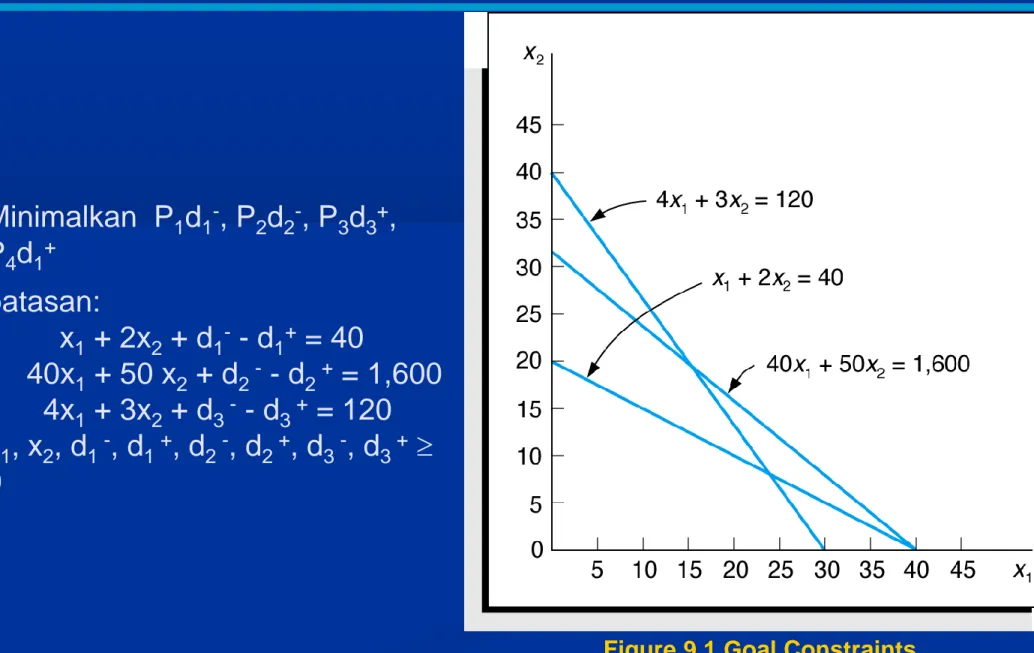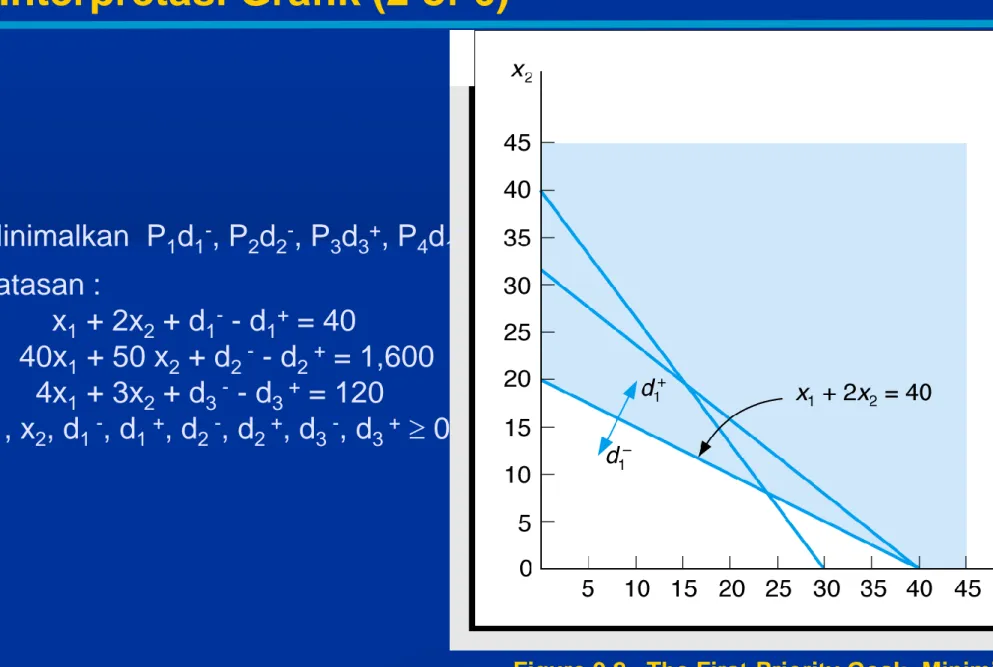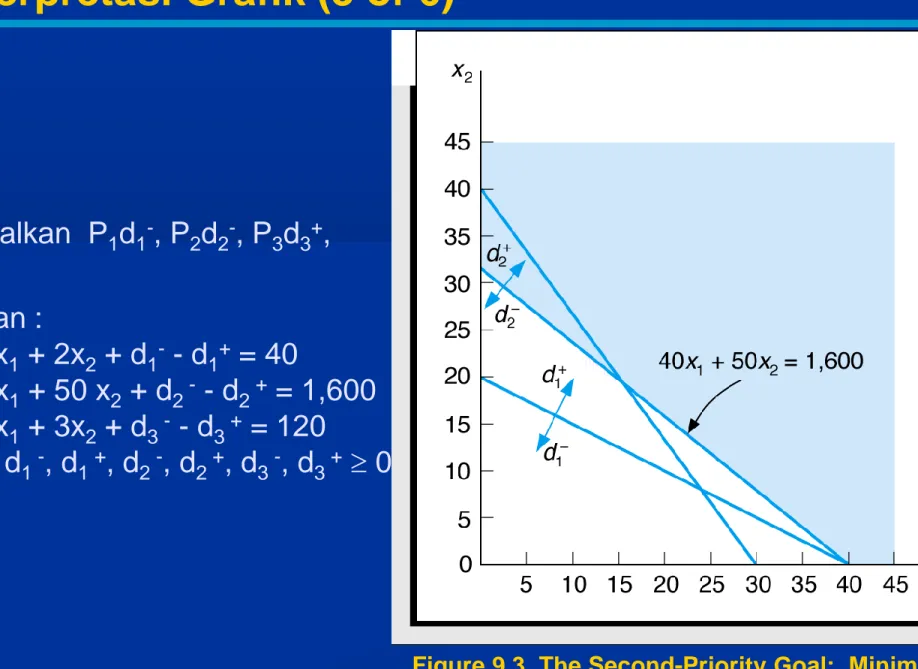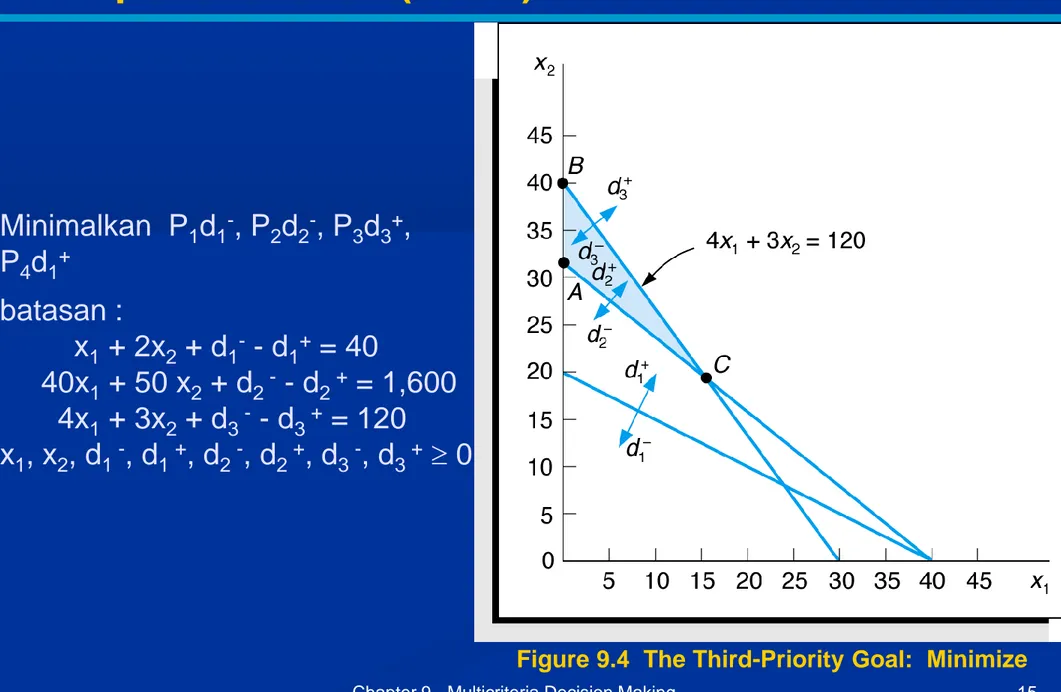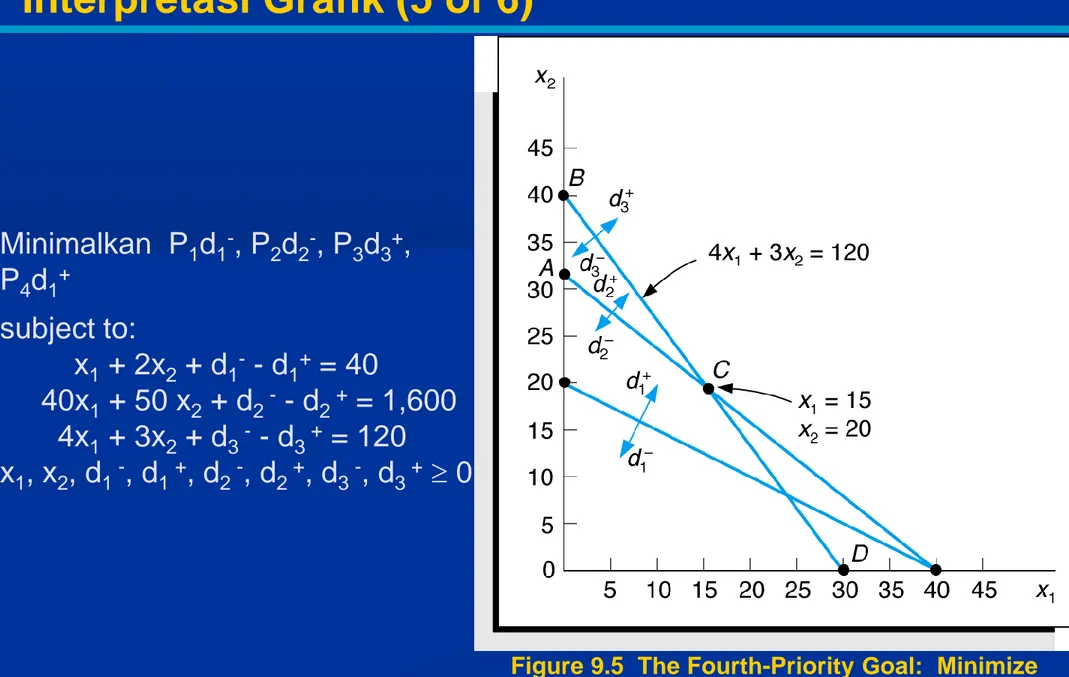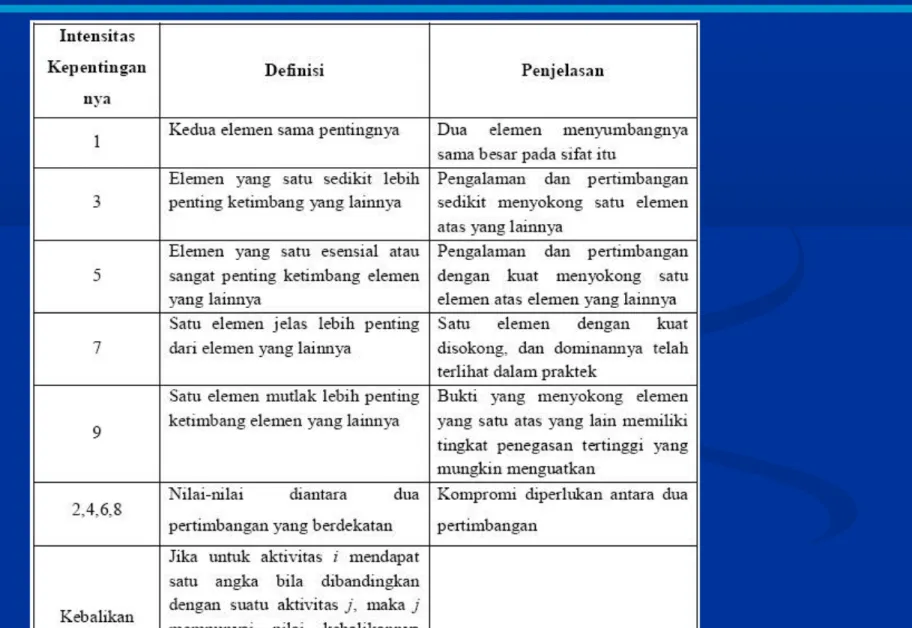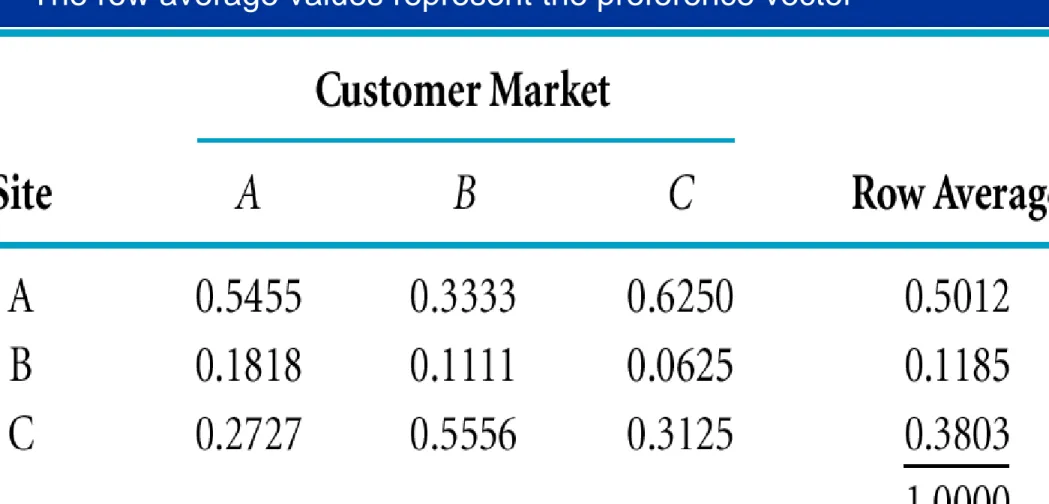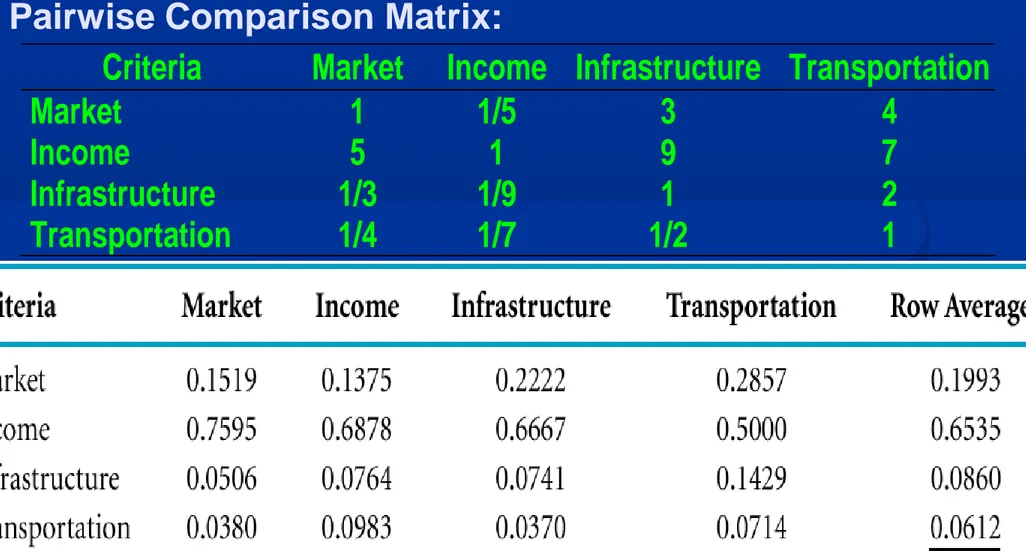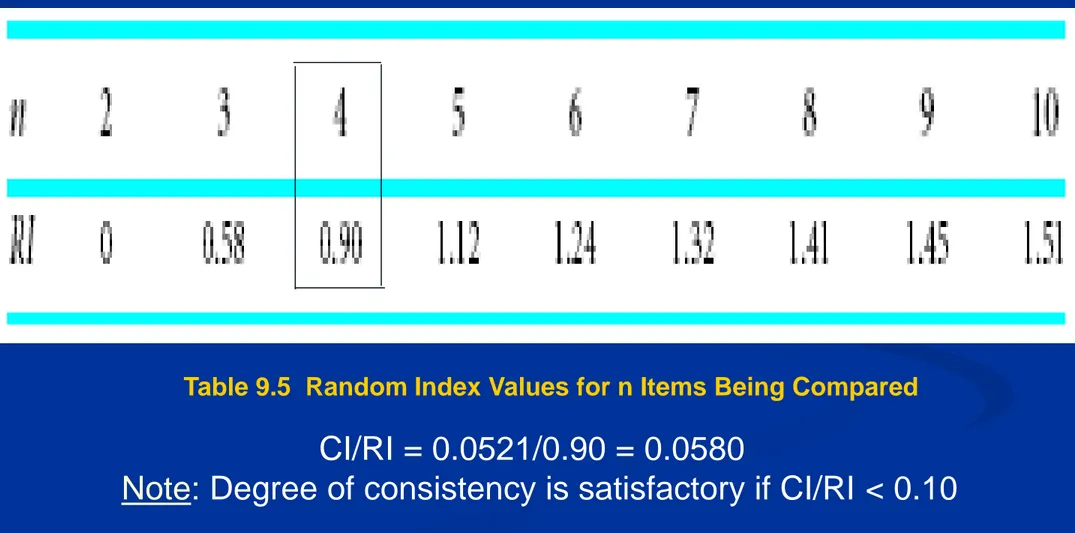Chapter 9
Multicriteria Decision Making
Introduction to Management Science
9
thEdition
by Bernard W. Taylor III
Goal Programming
Interpretasi grafis dari Goal Programming
Solusi komputer masalh Goal Programming dengan QM for Windows and Excel
Analytical Hierarchy Process Scoring Models
Pembelajaran permasalahan dengan beberapa kriteria, multiple criteria,
bukan satu tujuan ketika membuat keputusan.
Tiga teknik yang dibahas: goal programming, analytical hierarchy process dan scoring models.
Goal programming adalah variasi dari program linier
mempertimbangkan lebih dari satu tujuan (goals) dalam fungsi tujuan. Analytical hierarchy process (AHP) merupakan memberian skor untuk setiap alternatif keputusan berdasarkan perbandingan masing-masing di bawah kriteria yang berbeda yang mencerminkan preferensi
pengambil keputusan..
Scoring models Model Scoring didasarkan pada teknik perkalian scoring yang relatif sederhana
Contoh Beaver Creek Pottery Company
Maksimalkan Z = $40x1 + 50x2 Batasan:
1x1 + 2x2 40 jam kerja
4x1 + 3x2 120 pon tanah liat x1, x2 0
Dimana: x1 = Jumlah produksi mangkok x2 = Jumlah produksi mug
Menambahkan tujuan (goals) dalam urutan kepentingan, perusahaan:
Tidak ingin menggunakan kurang dari 40 jam kerja per hari.
Ingin mencapai tingkat laba yang memuaskan dari $ 1.600 per hari.
Memilih untuk tidak menyimpan lebih dari 120 pon tanah liat di tangan setiap hari.
Ingin meminimalkan jumlah lembur.
Semua kendala tujuan adalah kesetaraan yang meliputi variabel deviasi d- dan d +.
Sebuah variabel deviasi positif (d +) adalah jumlah dimana tingkat tujuan terlampaui.
Variabel deviasi negatif (d-) adalah jumlah dimana tingkat tujuannya adalah di bawah tercapai.
Setidaknya satu atau kedua variabel deviasi dalam kendala tujuan harus sama dengan nol.
Fungsi tujuan dalam model goal programming untuk
meminimalkan penyimpangan dari tujuan masing-masing dalam urutan prioritas tujuan.
Goal Programming
Kendala Tujuan
Tujuan Jam Kerja:
x
1+ 2x
2+ d
1-- d
1+= 40 (jam/hari)
Tujuan Keuntungan:
40x
1+ 50 x
2+ d
2 -- d
2 += 1,600 ($/hari)
Tujuan Material:
4x
1+ 3x
2+ d
3 -- d
3 += 120 (tanah liat/hari)
Model Formulasi Goal Programming
Kendala Tujuan (1 of 3)
Kendala Tujuan Jam Kerja (prioritas 1 - kurang dari 40 jam kerja, prioritas 4 – minimum lembur ):
Minimalkan P1d1-, P
4d1+
Kendala Penambahan Tujuan keuntungan (prioritas 2 -mencapai keuntungan sebesar $ 1.600):
Minimalkan P1d1-, P
2d2-, P4d1+
Kendala Penambahan Tujuan Material (prioritas 3
-menghindari menjaga lebih dari 120 pon tanah liat di tangan): Minimalkan P1d1-, P2d2-, P3d3+, P4d1+
Model Formulasi Goal Programming
Fungsi Objektif (2 of 3)
Model Lengkap Goal Programming : Minimalkan P1d1-, P 2d2-, P3d3+, P4d1+ batasan: x1 + 2x2 + d1- - d 1+ = 40 (jam kerja) 40x1 + 50 x2 + d2 - - d2 + = 1,600 (keuntungan) 4x1 + 3x2 + d3 - - d 3 + = 120 (tanah liat) x1, x2, d1 -, d 1 +, d2 -, d2 +, d3 -, d3 + 0
Model Formulasi Goal Programming
Model Lengkap (3 of 3)
Mengubah keempat prioritas tujuan "batas lembur untuk 10 jam" bukannya meminimalkan lembur:
d1- + d
4 - - d4+ = 10
minimalkan P1d1 -, P
2d2 -, P3d3 +, P4d4 +
Penambahan kelima prioritas tujuan "penting untuk mencapai tujuan untuk mug":
x1 + d5 - = 30 mangkok
x2 + d6 - = 20 mug
minimalkan P1d1 -, P2d2 -, P3d3 +, P4d4 +, 4P5d5 - + 5P5d6
-Goal Programming
Goal Programming
Alternative Forms of Goal Constraints (2 of 2)
Model Lengkap dengan menambahkan Tujuan Baru:
Minimalkan P1d1-, P 2d2-, P3d3+, P4d4+, 4P5d5- + 5P5d6 -batasan: x1 + 2x2 + d1- - d 1+ = 40 40x1 + 50x2 + d2- - d 2+ = 1,600 4x1 + 3x2 + d3- - d 3+ = 120 d1+ + d 4- - d4+ = 10 x1 + d5- = 30 x2 + d6- = 20 x1, x2, d1-, d 1+, d2-, d2+, d3-, d3+, d4-, d4+, d5-, d6- 0
Minimalkan P1d1-, P 2d2-, P3d3+, P4d1+ batasan: x1 + 2x2 + d1- - d 1+ = 40 40x1 + 50 x2 + d2 - - d 2 + = 1,600 4x1 + 3x2 + d3 - - d 3 + = 120 x1, x2, d1 -, d 1 +, d2 -, d2 +, d3 -, d3 + 0
Figure 9.1 Goal Constraints
Goal Programming
Figure 9.2 The First-Priority Goal: Minimize Minimalkan P1d1-, P 2d2-, P3d3+, P4d1+ batasan : x1 + 2x2 + d1- - d 1+ = 40 40x1 + 50 x2 + d2 - - d 2 + = 1,600 4x1 + 3x2 + d3 - - d 3 + = 120 x1, x2, d1 -, d 1 +, d2 -, d2 +, d3 -, d3 + 0
Goal Programming
Interpretasi Grafik (2 of 6)
Figure 9.3 The Second-Priority Goal: Minimize Minimalkan P1d1-, P 2d2-, P3d3+, P4d1+ batasan : x1 + 2x2 + d1- - d 1+ = 40 40x1 + 50 x2 + d2 - - d 2 + = 1,600 4x1 + 3x2 + d3 - - d 3 + = 120 x1, x2, d1 -, d 1 +, d2 -, d2 +, d3 -, d3 + 0
Goal Programming
Interpretasi Grafik (3 of 6)
Figure 9.4 The Third-Priority Goal: Minimize Minimalkan P1d1-, P 2d2-, P3d3+, P4d1+ batasan : x1 + 2x2 + d1- - d 1+ = 40 40x1 + 50 x2 + d2 - - d 2 + = 1,600 4x1 + 3x2 + d3 - - d 3 + = 120 x1, x2, d1 -, d 1 +, d2 -, d2 +, d3 -, d3 + 0
Goal Programming
Interpretasi Grafik (4 of 6)
Figure 9.5 The Fourth-Priority Goal: Minimize Minimalkan P1d1-, P 2d2-, P3d3+, P4d1+ subject to: x1 + 2x2 + d1- - d 1+ = 40 40x1 + 50 x2 + d2 - - d 2 + = 1,600 4x1 + 3x2 + d3 - - d 3 + = 120 x1, x2, d1 -, d 1 +, d2 -, d2 +, d3 -, d3 + 0
Goal Programming
Interpretasi Grafik (5 of 6)
Solusi goal programming tidak selalu mencapai semua
tujuan dan tidak "optimal", mencapai yang terbaik atau yang paling memuaskan solusi yang mungkin.
Minimalkan P1d1-, P 2d2-, P3d3+, P4d1+ batasan: x1 + 2x2 + d1- - d 1+ = 40 40x1 + 50 x2 + d2 - - d 2 + = 1,600 4x1 + 3x2 + d3 - - d 3 + = 120 x1, x2, d1 -, d 1 +, d2 -, d2 +, d3 -, d3 + 0 Solusi: x1 = 15 mangkok x2 = 20 mug d1- = 15 jam
Goal Programming
Interpretasi Grafik (6 of 6)
Exhibit 9.4
Goal Programming
Exhibit 9.5
Goal Programming
Exhibit 9.6
Goal Programming
Minimize P1d1-, P2d2-, P3d3+, P4d4+, 4P5d5- + 5P5d6 -subject to: x1 + 2x2 + d1- - d 1+ = 40 40x1 + 50x2 + d2- - d 2+ = 1,600 4x1 + 3x2 + d3- - d 3+ = 120 d1+ + d 4- - d4+ = 10 x1 + d5- = 30 x2 + d6- = 20 x1, x2, d1-, d 1+, d2-, d2+, d3-, d3+, d4-, d4+, d5-, d6- 0
Goal Programming
Exhibit 9.7
Goal Programming
Exhibit 9.8
Goal Programming
Exhibit 9.9
Goal Programming
Exhibit 9.10
Goal Programming
Exhibit 9.11
Goal Programming
AHP merupakan metode untuk merangking beberapa alternatif keputusan dan menyeleksi yang terbaik
pengambil keputusan mempunyai banyak tujuan dan kriteria yang mendasari keputusan.
Pengambil keputusan membuat keputusan berdasarkan bagaimana alternatif dibandingkan menurut beberapa kriteria.
Pembuat keputusan akan alternatif yang paling memenuhi kriteria keputusan nya.
AHP adalah proses untuk mengembangkan nilai numerik untuk menentukan peringkat masing-masing alternatif
keputusan berdasarkan seberapa baik alternatif memenuhi kriteria pembuat keputusan.
Analytical Hierarchy Process
Overview
Southcorp Development Company shopping mall site selection.
Three potential sites: Atlanta
Birmingham Charlotte.
Perbandingan kriteria untuk tempat : Customer market base.
Income level Infrastructure Transportation
Analytical Hierarchy Process
Contoh
Top of the hierarchy: the objective (select the best site).
Second level: how the four criteria contribute to the objective.
Third level: how each of the three alternatives contributes to each of the four criteria.
Analytical Hierarchy Process
Hierarchy Structure
Mathematically determine preferences for sites with respect to each criterion.
Mathematically determine preferences for criteria (rank order of importance).
Combine these two sets of preferences to mathematically derive a composite score for each site.
Select the site with the highest score.
Analytical Hierarchy Process
General Mathematical Process
In a pairwise comparison, two alternatives are compared according to a criterion and one is preferred.
A preference scale assigns numerical values to different levels of performance.
Analytical Hierarchy Process
Pairwise Comparisons (1 of 2)
Table 9.1 Preference Scale for Pairwise Comparisons
Analytical Hierarchy Process
Pairwise Comparisons (2 of 2)
Income Level Infrastructure Transportation A B C 1 9 3 1/9 1 1/6 1/3 6 1 1 1/7 1 7 1 3 1 1/3 1 1 1/4 2 4 1 3 1/2 1/3 1 Customer Market Site A B C A B C 1 1/3 1/2 3 1 5 2 1/5 1
Analytical Hierarchy Process
Pairwise Comparison Matrix
A pairwise comparison matrix summarizes the pairwise comparisons for a criteria.
Customer Market Site A B C A B C 1 1/3 1/2 11/6 3 1 5 9 2 1/5 1 16/5
Customer Market
Site
A
B
C
A
B
C
6/11
2/11
3/11
3/9
1/9
5/9
5/8
1/16
5/16
Analytical Hierarchy Process
Developing Preferences Within Criteria (1 of 3)
In synthesization, decision alternatives are prioritized with each criterion and then normalized:
Table 9.2 The Normalized Matrix with Row Averages
Analytical Hierarchy Process
Developing Preferences Within Criteria (2 of 3)
Table 9.3 Criteria Preference Matrix
Analytical Hierarchy Process
Developing Preferences Within Criteria (3 of 3)
Preference vectors for other criteria are computed similarly, resulting in the preference matrix
Criteria Market Income Infrastructure Transportation Market Income Infrastructure Transportation 1 5 1/3 1/4 1/5 1 1/9 1/7 3 9 1 1/2 4 7 2 1
Table 9.4 Normalized Matrix for Criteria with Row Averages
Analytical Hierarchy Process
Ranking the Criteria (1 of 2)
0.0612 0.0860 0.6535 0.1993
Analytical Hierarchy Process
Ranking the Criteria (2 of 2)
Preference Vector for Criteria:
Market Income
Infrastructure Transportation
Overall Score: Site A score = .1993(.5012) + .6535(.2819) + .0860(.1790) + .0612(.1561) = .3091 Site B score = .1993(.1185) + .6535(.0598) + .0860(.6850) + .0612(.6196) = .1595 Site C score = .1993(.3803) + .6535(.6583) + .0860(.1360) + .0612(.2243) = .5314 Overall Ranking:
Site
Score
Charlotte
Atlanta
Birmingham
0.5314
0.3091
0.1595
1.0000
Analytical Hierarchy Process
Developing an Overall Ranking
Analytical Hierarchy Process
Summary of Mathematical Steps
Develop a pairwise comparison matrix for each decision alternative for each criteria.
Synthesization
Sum the values of each column of the pairwise comparison matrices.
Divide each value in each column by the corresponding column sum.
Average the values in each row of the normalized matrices. Combine the vectors of preferences for each criterion.
Develop a pairwise comparison matrix for the criteria. Compute the normalized matrix.
Develop the preference vector.
Compute an overall score for each decision alternative Rank the decision alternatives.
Analytical Hierarchy Process: Consistency (1 of 3)
Consistency Index (CI): Check for consistency and validity of multiple pairwise comparisons
Example: Southcorp’s consistency in the pairwise comparisons of the 4 site selection criteria
Step 1: Multiply the pairwise comparison matrix of the 4 criteria
by its preference vector
Market Income Infrastruc. Transp. Criteria Market 1 1/5 3 4 0.1993 Income 5 1 9 7 X 0.6535 Infrastructure 1/3 1/9 1 2 0.0860 Transportation 1/4 1/7 1/2 1 0.0612 (1)(.1993)+(1/5)(.6535)+(3)(.0860)+(4)(.0612) = 0.8328 (5)(.1993)+(1)(.6535)+(9)(.0860)+(7)(.0612) = 2.8524 (1/3)(.1993)+(1/9)(.6535)+(1)(.0860)+(2)(.0612) = 0.3474 (1/4)(.1993)+(1/7)(.6535)+(1/2)(.0860)+(1)(.0612) = 0.2473
Analytical Hierarchy Process: Consistency (2 of 3)
Step 2: Divide each value by the corresponding weight from the
preference vector and compute the average 0.8328/0.1993 = 4.1786 2.8524/0.6535 = 4.3648 0.3474/0.0860 = 4.0401 0.2473/0.0612 = 4.0422 16.257 Average = 16.257/4 = 4.1564
Step 3: Calculate the Consistency Index (CI)
CI = (Average – n)/(n-1), where n is no. of items compared CI = (4.1564-4)/(4-1) = 0.0521
Analytical Hierarchy Process: Consistency (3 of 3)
Step 4: Compute the Ratio CI/RI
where RI is a random index value obtained from Table 9.5
Table 9.5 Random Index Values for n Items Being Compared
CI/RI = 0.0521/0.90 = 0.0580
Exhibit 9.12
Analytical Hierarchy Process Excel Spreadsheets (1 of 4)
Exhibit 9.13
Analytical Hierarchy Process Excel Spreadsheets (2 of 4)
Exhibit 9.14
Analytical Hierarchy Process Excel Spreadsheets (3 of 4)
Exhibit 9.15
Analytical Hierarchy Process Excel Spreadsheets (4 of 4)
Each decision alternative graded in terms of how well it satisfies the criterion according to following formula:
Si = gijwj where:
wj = a weight between 0 and 1.00 assigned to criterion j; 1.00 important, 0 unimportant; sum of total weights
equals one.
gij = a grade between 0 and 100 indicating how well alternative i satisfies criteria j; 100 indicates high
satisfaction, 0 low satisfaction.
Scoring Model
Overview
Mall selection with four alternatives and five criteria:
S1 = (.30)(40) + (.25)(75) + (.25)(60) + (.10)(90) + (.10)(80) = 62.75 S2 = (.30)(60) + (.25)(80) + (.25)(90) + (.10)(100) + (.10)(30) = 73.50 S3 = (.30)(90) + (.25)(65) + (.25)(79) + (.10)(80) + (.10)(50) = 76.00 S4 = (.30)(60) + (.25)(90) + (.25)(85) + (.10)(90) + (.10)(70) = 77.75
Mall 4 preferred because of highest score, followed by malls 3, 2, 1.
Grades for Alternative (0 to 100) Decision Criteria
Weight
(0 to 1.00) Mall 1 Mall 2 Mall 3 Mall 4 School proximity
Median income Vehicular traffic Mall quality, size Other shopping 0.30 0.25 0.25 0.10 0.10 40 75 60 90 80 60 80 90 100 30 90 65 79 80 50 60 90 85 90 70
Scoring Model
Example Problem
Exhibit 9.16
Scoring Model
Excel Solution
Goal Programming Example Problem
Problem Statement
Public relations firm survey interviewer staffing requirements determination.
One person can conduct 80 telephone interviews or 40 personal interviews per day.
$50/ day for telephone interviewer; $70 for personal interviewer. Goals (in priority order):
At least 3,000 total interviews.
Interviewer conducts only one type of interview each day. Maintain daily budget of $2,500.
At least 1,000 interviews should be by telephone.
Formulate a goal programming model to determine number of
interviewers to hire in order to satisfy the goals, and then solve the problem.
Purchasing decision, three model alternatives, three decision criteria.
Pairwise comparison matrices:
Prioritized decision criteria:
Price Bike X Y Z X Y Z 1 1/3 1/6 3 1 1/2 6 2 1 Gear Action Bike X Y Z X Y Z 1 3 7 1/3 1 4 1/7 1/4 1 Weight/Durability Bike X Y Z X Y Z 1 1/3 1 3 1 2 1 1/2 1
Criteria Price Gears Weight Price Gears Weight 1 1/3 1/5 3 1 1/2 5 2 1
Analytical Hierarchy Process Example Problem
Problem Statement
Step 1: Develop normalized matrices and preference
vectors for all the pairwise comparison matrices for criteria.
Price
Bike X Y Z Row Averages
X Y Z 0.6667 0.2222 0.1111 0.6667 0.2222 0.1111 0.6667 0.2222 0.1111 0.6667 0.2222 0.1111 1.0000 Gear Action
Bike X Y Z Row Averages
X Y Z 0.0909 0.2727 0.6364 0.0625 0.1875 0.7500 0.1026 0.1795 0.7179 0.0853 0.2132 0.7014 1.0000
Analytical Hierarchy Process Example Problem Problem Solution (1 of 4)
Weight/Durability
Bike X Y Z Row Averages
X Y Z 0.4286 0.1429 0.4286 0.5000 0.1667 0.3333 0.4000 0.2000 0.4000 0.4429 0.1698 0.3873 1.0000 Criteria
Bike Price Gears Weight
X Y Z 0.6667 0.2222 0.1111 0.0853 0.2132 0.7014 0.4429 0.1698 0.3873
Step 1 continued: Develop normalized matrices and
preference vectors for all the pairwise comparison matrices for criteria.
Analytical Hierarchy Process Example Problem Problem Solution (2 of 4)
Step 2: Rank the criteria. Price Gears Weight 0.1222 0.2299 0.6479
Criteria Price Gears Weight Row Averages Price Gears Weight 0.6522 0.2174 0.1304 0.6667 0.2222 0.1111 0.6250 0.2500 0.1250 0.6479 0.2299 0.1222 1.0000
Analytical Hierarchy Process Example Problem Problem Solution (3 of 4)
Step 3: Develop an overall ranking. Bike X Bike Y Bike Z Bike X score = .6667(.6479) + .0853(.2299) + .4429(.1222) = .5057 Bike Y score = .2222(.6479) + .2132(.2299) + .1698(.1222) = .2138 Bike Z score = .1111(.6479) + .7014(.2299) + .3873(.1222) = .2806
Overall ranking of bikes: X first followed by Z and Y (sum of scores equal 1.0000). 1222 . 0 2299 . 0 6479 . 0 3837 . 0 7014 . 0 1111 . 0 1698 . 0 2132 . 0 2222 . 0 4429 . 0 0853 . 0 6667 . 0
Analytical Hierarchy Process Example Problem Problem Solution (4 of 4)
